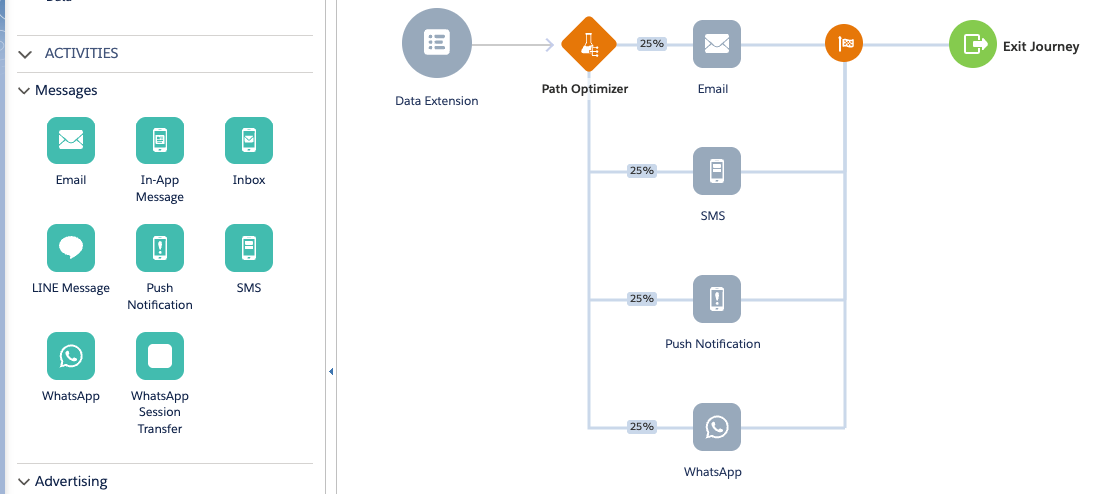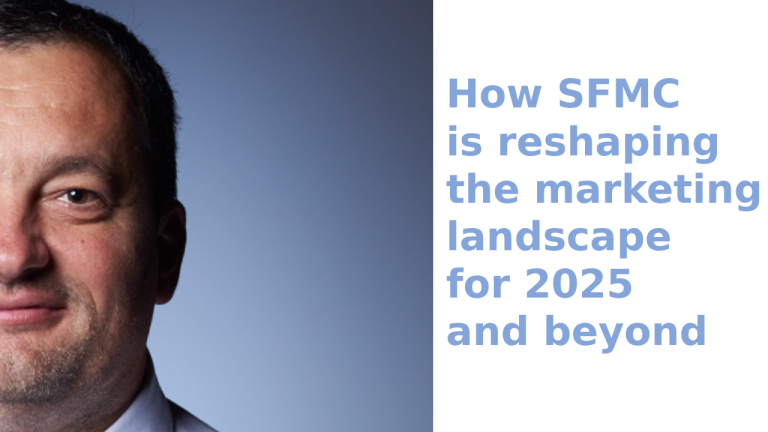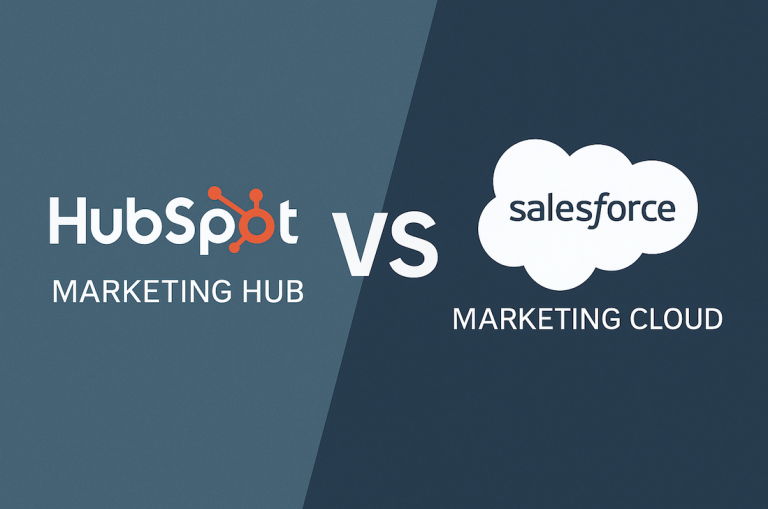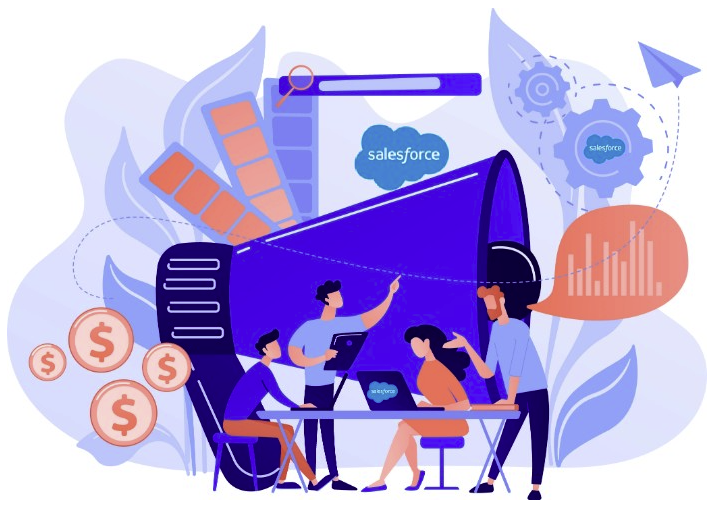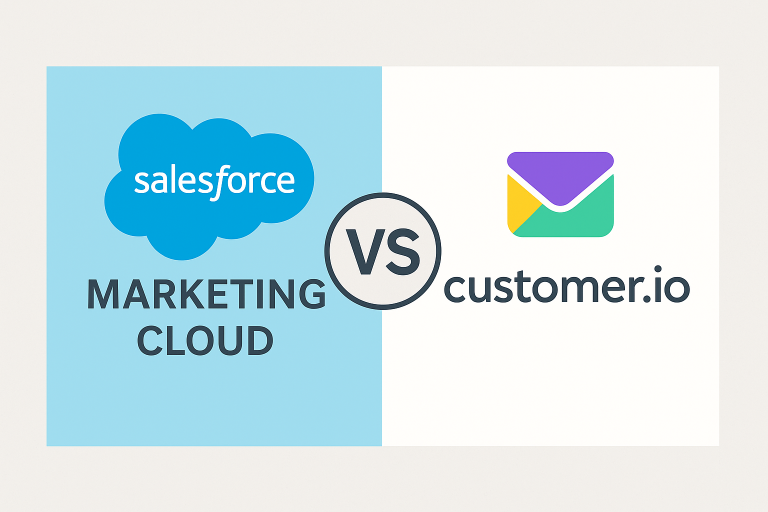Path Optimizer in Salesforce Marketing Cloud Journey Builder
Salesforce Marketing Cloud Journey Builder’s Path Optimizer lets marketers run up to 10 simultaneous “A/B/n” tests on a journey to identify the most effective path.
It automates multivariate testing (e.g. different email subject lines, content blocks, channels, or timing) within a single journey, selecting the winning variant based on engagement metrics (opens, clicks, unsubscribes) without needing separate campaign drafts.
By treating campaigns like scientific experiments, Path Optimizer delivers data-driven insights (often in days instead of weeks) and continuously improves customer communications.
Strategic Benefits of Path Optimizer
- Faster, Data-Driven Optimization: Path Optimizer accelerates experimentation by testing many variations in parallel.
For example, in a welcome-email campaign, a marketer tested four email variants (with/without SMS follow-up) and identified the 27% open-rate winner in just 7 days, time that would otherwise take weeks of sequential tests. - Improved Engagement and ROI: Multivariate testing consistently boosts results. Firms that frequently A/B test email content see dramatically higher returns – brands that test often achieve ~42:1 ROI versus 23:1 for those that don’t litmus.com.
In retail/e-commerce, marketing emails already average ~45:1 ROI; applying Path Optimizer’s refinements can further lift conversions and revenue.
In one Forrester study, Marketing Cloud users saw a 60% increase in conversion rates and 35% higher order value over 3 years (gains that Path Optimizer helps enable through better personalization and timing). - Cross-Channel Experimentation: Path Optimizer isn’t limited to email. You can test different channels or timing, such as sending an SMS vs. email follow-up.
For example, one path might include an SMS reminder after an email, another might not – Path Optimizer will determine which approach yields higher engagement. This multichannel testing is critical as customers increasingly interact on multiple platforms. - Customization & Personalization: The tool supports testing of personalized elements. Marketers can compare dynamic content, personalized subject lines, or customized CTAs.
Industry data show personalized subject lines alone can raise open rates ~26% nptechforgood.com.
Path Optimizer helps identify the best combination of personalization tactics for each audience segment. - Time and Resource Savings: Automating tests within a journey cuts manual work. The same Forrester study found Marketing Cloud users saved ~60% of campaign build time through automation.
Path Optimizer contributes by removing the need to create and merge separate test journeys.
Instead of coding multiple journeys for each hypothesis, marketers drag-and-drop one Path Optimizer activity into a single journey to run all tests simultaneously. This agility lets teams iterate rapidly.
Industry-Specific Advantages
| Industry | Path Optimizer Use Cases | Benefits / Impact |
|---|---|---|
| E-commerce | – Test promotional email designs, subject lines, or timing (e.g. day-of-week sends); – Compare outreach channels (email vs push/SMS). | Higher open/click rates, increased sales. Example: Retailers that experiment with email content often see large uplifts in revenue – Marketing Cloud users saw 60% higher conversion in one study salesforce.com. By optimizing offers (e.g. cart recovery flow) in real time, e-commerce brands can maximize customer lifetime value and average order size (which rose ~35% in 3 years for MC users salesforce.com). |
| Financial Services | – Test onboarding and cross-sell journeys: e-statements subject lines, educational content vs. FAQ messaging, or different call-to-action placements. – Also trial different channels for alerts (SMS vs email). | Improved customer engagement and retention. Financial marketers often deal with low-margin upsells, so even small % improvements boost revenue. Path Optimizer ensures compliance messages get maximum attention. For example, optimizing credit-card welcome paths can drive higher click-throughs to digital banking, increasing active user rates. (Marketing Cloud automations overall helped companies boost site conversions ~60% salesforce.com, partly via better-targeted journeys.) |
| Non-profit | – Test fundraising appeals, event invitation emails, or donor thank-you messages. – Compare storytelling approaches or CTA wording in donation emails. – Also test email frequency to avoid fatigue. | More donations and donor engagement. Nonprofits saw a large benefit from optimized messaging: one case study noted an 8–10% lift in open and click rates after iteratively refining email contentfusionspan.com. Path Optimizer would automate these refinements. For context, nonprofits average ~28.6% open rates and 3.3% clicks on emailsnptechforgood.com; testing can move those rates upward. (Welcome emails can reach ~80% open ratesnptechforgood.com, highlighting value of the right timing.) Optimizing appeals can translate into significantly more donor conversions. |
By industry examples:
For a retail brand, Path Optimizer could reveal that a simple subject-line change increases open rate by X%, boosting sales;
For a bank, it might show an SMS follow-up yields more account activations than a second email.
In nonprofits, small percentage gains in email performance translate to substantial fundraising increases. Overall, Path Optimizer’s systematic testing supports strategic goals in any sector.
How Path Optimizer Works (Setup & Best Practices)
To implement Path Optimizer, add the Path Optimizer “Flow Control” activity to your journey canvas in Marketing Cloud and configure its parameters. Key settings include:
- Winner Type:
Choose Email Engagement (auto-pick winner by highest opens/clicks or lowest unsubscribes) or Manual (pick based on your own external metric) jbitra.com. - Engagement Period:
Set how long to run the test before declaring a winner (e.g. 1–7 days). During this period, contacts are split across all paths, and data is collected for the chosen metric. - Split (Paths): Define 2–10 variant paths and allocate contact percentages for each. Each path runs a different version of the campaign (different email subject/content, different channel, etc.).
- Holdback (Control): Optionally withhold a percentage of contacts until a winner is selected, then send them the winning path. This ensures those held-back contacts see the optimized treatment after testing.
Best Practices:
- Isolate Variables: Change only one major element per path for clarity.
For example, test only subject lines or only send times at once. Marketing Cloud documentation suggests testing subject lines, personalization, content, or timing separately to pinpoint what drives engagement. - Choose Meaningful Metrics: Use metrics aligned to campaign goals.
Email Engagement (the built-in metric) aggregates opens, clicks, unsubscribes over all emails in a path.
For brand awareness, measure opens; for conversion, measure clicks or form submissions (using a manual win if needed). - Ensure Sufficient Sample Size: Path Optimizer splits contacts randomly.
Ensure each path has enough volume to reach statistical confidence during the engagement period. - Monitor Results: As the test runs, Journey Builder reports interim metrics. After the engagement period, Path Optimizer declares a winner (automatic or manual).
You can then copy the journey – if you copy with a chosen winner, only that path remains, simplifying future campaigns. - Iterate Continuously: Even after a winner is selected, continue testing future changes. Path Optimizer facilitates a culture of continuous improvement: about 90% of new ideas may fail to improve results, so you need many experiments.
The more tests you run, the more you learn – and the lower the risk that you miss a breakthrough.
Integration tip:
Combine Path Optimizer with Einstein features.
For example, you can use Einstein Send-Time Optimization (STO) on each path to send at the optimal time for recipients, or Einstein Subject Line Comparison to generate strong subject lines.
Path Optimizer then determines which combination (content + send time) works best. According to one guide: “Offer something different, set Send Time Optimization… use a different cadence, etc.” as part of experimentation jbitra.com.
Drawbacks of Not Using Path Optimizer
Failing to leverage Path Optimizer means relying on guesswork or sequential tests, which carries risks:
- Slower, Less Effective Campaigns: Without automated multivariate testing, marketers must run separate campaigns or manually A/B test one variable at a time.
This slows the learning cycle and can delay optimization by weeks or months.
In the Trailhead example, insights took “7 days… that would’ve taken weeks” using traditional methods trailhead.salesforce.com.
Missing these fast feedback loops means lagging behind competitors who iterate quickly. - Lower Engagement and Revenue: Not testing content leads to suboptimal messaging. Data shows that marketers who don’t A/B test have significantly lower ROI (about 23:1) than those who test often (~42:1) litmus.com.
In practical terms, ignoring optimization may mean sending emails with lower open/click rates – cutting into sales and fundraising.
For instance, personalized subject lines boost opens by ~26% nptechforgood.com; skipping such tests forfeits that lift. - Wasted Spend and Effort: Sending unwanted or mistimed messages hurts efficiency. The Forrester study found Marketing Cloud automations cut campaign build time by ~60% salesforce.com.
Without Path Optimizer, teams spend much more time building multiple journeys and analyzing reports manually. This inefficient process ties up resources that could be used for new campaigns or strategy. - Missed Opportunities and Loyalty Risk: Inability to identify the best outreach risks alienating customers. Poorly performing paths (higher unsubscribes or low engagement) can be avoided if known.
Path Optimizer can even optimize to minimize unsubscribes (by picking the path with the fewest opt-outs).
Without it, companies may inadvertently damage customer relationships by sending generic, untuned messaging.
In summary, not using Path Optimizer risks stagnation. Marketers miss out on data-backed improvements – essentially leaving growth on the table.
Automated testing is a competitive necessity; as one expert notes, “experimentation and … continuous testing” is key to success jbitra.com. Skipping Path Optimizer means forgoing that edge.
Case Studies & Performance Data
While Path Optimizer is a relatively not a new feature, related data and case studies illustrate its impact on engagement and ROI:
- Marketing Cloud ROI (General): A 2023 Forrester-commissioned study of Marketing Cloud users (across industries) showed 299% ROI over three years.
They reported +60% site conversion rates and +35% average order value by year 3.
Path Optimizer contributes to these gains by fine-tuning messaging and timing in journeys, helping replicate such improvements. - Email A/B Testing Benefits: Industry benchmarks confirm testing’s power. Litmus found that brands using A/B testing saw an 82% higher email ROI – on average 42:1 vs 23:1 – compared to those that never test litmus.com.
In the retail sector, email ROI averages ~45:1.
For an e-commerce use case, applying Path Optimizer (testing subject lines, offers, frequency) could shift an otherwise average campaign to the higher end of that range, turning small open-rate gains into significant revenue. - Engagement Uplift Example (Nonprofit): A nonprofit case study reports concrete gains from testing and iteration. After sending an initial donor-journey email, the team added hero images and clear CTAs in a second wave.
These tweaks “significantly improved both open and click rates, with an increase of at least 8% in each metric” fusionspan.com.
Using Path Optimizer, such improvements could be identified automatically and earlier.
(Improving open/click by ~8% in a $5 million campaign, for example, would be $400k more donor engagement.) - List Growth & Personalization (Nonprofit): Nonprofits see dramatic gains with personalization and timely sends.
Over 70% of new subscribers expect a welcome email; welcome emails can average 80% open rates nptechforgood.com.
Using Path Optimizer to test welcome-message content or timing can capture this engagement.
Likewise, personalized subject lines increase open rates by ~26%, and personalized CTAs convert 202% better.
Path Optimizer can test these elements (e.g. personalized vs generic subject) to ensure donors get the most compelling ask. - E-commerce Example: (Hypothetical) A retailer might run Path Optimizer on a cart-abandonment journey:
– Path A uses a percentage discount in the email,
– Path B uses a free-shipping offer,
– Path C uses a bonus gift image.
Over a 3-day test, the platform automatically favors the variant with the highest click-to-purchase rate.
Even a single percentage-point lift in conversion translates to large revenue gains at scale. While we don’t have a public stat for this exact scenario, studies show each 1% increase in conversion can mean millions more in e-commerce revenue for large retailers.
Path Optimizer makes finding that 1% easier and faster. - Financial Services Scenario: (Illustrative) A bank could test two versions of a new-account email: – one emphasizing convenience,
– the other security.
Path Optimizer will reveal which message leads to more new account sign-ups. Even though specific stat is internal, we know from that across industries, Marketing Cloud automations drove +60% conversion (year 3); optimizing financial offer messaging contributes to such lifts.
In practice, marketers in finance often see single-digit increases in loan or service uptake when email campaigns are better targeted – Path Optimizer helps discover those better-targeted approaches.
In summary, evidence shows that systematic testing and personalization (the core of Path Optimizer) yield real gains.
Marketers who embrace it see higher open/click rates, stronger conversion, and vastly improved ROI. By comparing real-world outcomes (as in the nonprofit example with +8% engagement) and industry benchmarks (42:1 vs 23:1 email ROI), it’s clear that Path Optimizer’s impact is measurable.
Every percent improvement counts – for example, raising a 28% open rate to 32% (above the nonprofit average) can mean dozens more donors per thousand addresses, or thousands more shoppers clicking through on sale emails.
Overall, Path Optimizer empowers marketers in e-commerce, financial services, non-profits (and beyond) to make each campaign better than the last.
It turns intuition into insight, avoids guesswork, and ensures marketing spend delivers the highest possible engagement and ROI.
Start experimenting and testing today using Path Optimizer!

